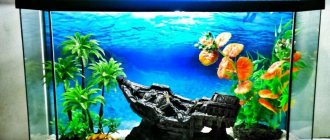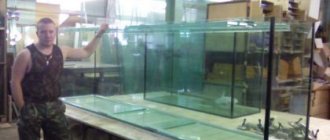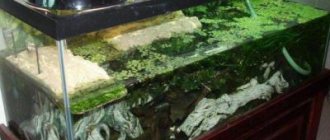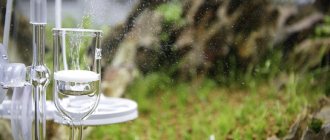Open waters are home to many plants and animals. And they all have a wonderful symbiosis: fish and frogs, processing sediment from the bottom, release CO2 into the water, which helps the plants not need anything.
This idyll occurs because, most often, the ratio of animals to plants in rivers is 3 to 1. Animals manage to produce exactly as much CO2 as is needed for the good development of these few plants, and therefore the plants do not face a carbon dioxide deficiency.
Why CO2 in an aquarium
Vegetation receives hydrocarbons in nature from the environment, the air, but in a closed reservoir you will have to take care of the hydrocarbon supply on your own. Plants are half hydrocarbon. Without carbon, vegetation will not be able to grow and develop normally. The carbon content must be high enough for the greenery to have optimal living conditions. Of course, fish and other living creatures produce carbon dioxide, but its concentration is so insignificant that it does not cover the needs of vegetation.
With an optimal carbon concentration, plants grow quickly, become stronger, and turn green. Regular supply of CO2 reduces acidity.
For normal life of vegetation, a hydrocarbon content is required in a ratio of 3-7 mg per 1 liter of water.
It is not necessary to buy devices for producing CO2 in a store; you can make a modern CO2 installation with your own hands. This does not require complex equipment or the purchase of instruments. The device can be made from available materials.
Device for supplying mash at home
Creating a device that supplies mash for an aquarium with your own hands will take only half an hour and will not require any effort or money. For construction you will need:
- transparent bottle with a lid, 2 liters;
- IV tube;
- spray;
- construction or aquarium sealant, which is better, everyone can choose for themselves.
In a closed bottle, make a hole in the cap of such a size that one end of the hose can easily penetrate inside the container. A hole is inserted into the dropper tube and the joints are treated with sealant so that carbon dioxide passes only through the hose. Thus, the aquarium mash in the bottle will release large bubbles of carbon dioxide, which enter the tank through the other end of the tube. However, co2 for an aquarium must be diluted in liquid, which means that the volume of bubbles must be reduced, otherwise they will simply rush to the surface and do no good.
For dissolution, use one of the following methods:
- the second end of the hose is connected to the filtration system;
- use a pump to liquefy bubbles;
- a sprig of rowan tree 1–1.5 cm long is inserted into the end of the hose;
- A sprayer is placed on the tip of the tube.
In order for the device to function fully, experienced aquarists resort to the following tips:
- containers with mash for an aquarium are packed in a cardboard box to protect from light;
- to control the temperature, the bottle is wrapped in insulating material: foam rubber or thick fabric;
- bread, brewer's yeast and ammonium salts are added to the co2 generator for the aquarium for feeding;
- the bottle is filled to 2/3 volume and placed in a vertical position.
Do-it-yourself methods for supplying CO2 to an aquarium
You can organize 4 ways to supply hydrocarbons to aquarium water at home:
- balloon;
- carbon-containing preparations;
- sparkling water.
Balloon method
The fastest way to produce carbon without special equipment, but you will have to spend money on cylinders with carbon dioxide and a device for supplying it. The cylinders can be refilled in the future, so maintenance will be inexpensive. You pay for the device once and use it without problems for many years.
Carbon-containing drugs
These drugs are sold in specialized stores in tablet form. 1 tablet once a week is enough to saturate the liquid with the required amount of carbon. Carbon-containing preparations are harmless to fish, greenery and other living creatures.
Sparkling water
This is the simplest and cheapest method of producing CO2 for a fish tank. Store-bought sparkling water contains a lot of hydrocarbons, which are needed by greenery and living inhabitants of the reservoir.
Experts recommend adding 20 ml every morning. gas water for every 10 liters of water. That is, for a 50 liter tank you will need 100 ml of gas water. This will be enough to saturate the liquid with carbon and create an optimal environment for aquatic life. Soda should be without added sugar. It is better to make soda yourself using a siphon from running water.
This method is applicable for small tanks up to 50 liters. Large tanks require the purchase of a separate gas supply system.
Supplying carbon dioxide with sparkling water
Many aquarists, thinking about such a question as a DIY system for supplying CO2 to an aquarium, do not even realize that the problem can be solved in a very simple way - carbonated mineral water. Bottles of mineral water with gas contain a significant amount of carbon dioxide - up to 10,000 mg/l. Even taking into account that after opening the container most of the gas disappears instantly, a decent portion of CO2 still remains in sparkling water - 1500 mg/l.
It should be immediately noted that the DIY method of supplying CO2 using sparkling water is only suitable for those tanks whose capacity does not exceed 50 liters. To introduce carbon dioxide, you just need to pour carbonated water into the pond every morning at the rate of 20 mm/10 liters of liquid. This amount will be enough for the representatives of the flora, and soon the green inhabitants will say “thank you” to the owner, demonstrating a blooming and healthy appearance.
Carbon dioxide production equipment
Device
To create the device you will need two plastic bottles with caps. We make 2 holes in the caps into which the tubes will be placed. One tube serves as a connector between two containers.
The second hole is necessary for a tee with tubes. One of the tubes will go into the container with the fish. In the middle of the tee it is necessary to place a tap to regulate the gas flow.
To uninterruptedly supply CO2 to the fish with your own hands, you need a CO2 generator. The CO2 generator is responsible for the degree of carbon supply.
You can make your own CO2 bubble counter from a syringe.
CO2 reactor
The reagents for the manufactured apparatus are soda and citric acid. In one bottle we place a solution of 100 grams of water and 60 grams of soda, and in the second – 50 grams of citric acid dissolved in 100 grams of water. Be sure to seal the bottle caps tightly.
We dip the ends of the tubes into solutions that are produced by mixing co2 in an aquarium. The gas passes through the tee to aquarium fish and plants. Before using reagents, it is recommended to check the device for leaks to prevent gas leakage.
Precautionary measures
When installing a CO2 generator in an aquarium, keep in mind that in addition to the positive aspects, there are also disadvantages of use; maintenance of the tank should be more thorough. If you made the CO2 system yourself:
- Monitor your carbon dioxide levels. To do this, use special tests.
- Control the acidity level. Most plants and animals love soft water. The former in such an environment absorb fertilizers better.
- Adjust the lighting. This is an important point for the process of photosynthesis. Even if the level of carbon dioxide in the water is sufficient, the process will not begin without sunlight.
- Feed your aquarium greens with fertilizers. They need microelements to live.
If you ignore the norm of these indicators, homemade products will lead to failure in the process of photosynthesis. Because of this, the fish will suffocate, the water will become cloudy, and an algae outbreak will occur. Therefore, when installing CO2 in an aquarium, remember that even the simplest and most harmless system, if used incorrectly, can harm the inhabitants of the tank.
Creating a DIY installation
There are a large number of CO2 supply units for aquariums on sale. But they all have several disadvantages - the CO2 reactor is expensive and bulky. Therefore, many aquarium lovers prefer a DIY CO2 installation. In terms of efficiency, it is not inferior to store-bought units, and its creation requires the most common materials that do not cost a lot of money.
For a CO2 unit in an aquarium you will need:
- colorless plastic bottle 2 liters. It serves as the basis for the fermentation process.
- plastic bottle with a wide neck. Serves as a filter in the installation.
- medical syringe with a volume of 5 cubic meters. It is used to count the number of bubbles.
- a dropper, or rather, a hose from it. It connects the elements of the system into one installation.
- sealed base, such as aquarium silicone.
- back pressure valve;
- hose or tube;
- special clamps for them in the form of suction cups;
- the sprayer is not an important, but desirable element of the installation.
When the parts are prepared, the CO2 supply system to the aquarium is assembled with your own hands according to the following scheme:
- Take the bottle cap and use a utility knife or sharp scissors to remove any existing partitions from it.
- Remove the plunger from the syringe. Cut off the bottom part. Place a back pressure valve into the device. Blow to test patency.
- Connect the syringe to the bottle cap. Use a sealant to seal any voids that appear. Pour water into the resulting device. Your DIY CO2 bubble counter is ready.
- Next, connect it to a large plastic bottle.
- Remove the adapter and flow regulator from the dropper. Take the cap from the second bottle and make a hole in it for the adapter.
- Using a needle, make another one next to the first one.
- Connect the hose to the adapter at the bottom of the cap. Lubricate with silicone. Fill the CO2 generator with water.
- Next, the installation is connected using hoses as follows: from a two-liter bottle, the end should be connected to the valve cap, from the needle - to the aquarium.
A simple diagram will help you quickly build a CO2 supply unit.
Compositions for installation
After the homemade CO2 system is ready, prepare a special composition that works based on fermentation. As a result of the process, carbon dioxide is released.
Here are some suitable recipes that work with an aquarium CO2 system:
- The first recipe for making carbon dioxide at home is based on fish food and soda. The mixture for supplying carbon dioxide to the aquarium is prepared as follows: a glass of sugar, a pinch of baking soda, half a teaspoon of crushed fish food are poured into a large bottle, a small piece of bread is added (can be replaced with dried apricots or raisins - 2 pieces), the most important ingredient is yeast. Both dry and “live” are suitable. After this, water, previously boiled and cooled to a warm state, is poured into the bottle. Do not pour right up to the neck, leave a gap of 5 cm. Close the homemade CO2 generator tightly. Lower the system sprayer into the aquarium. CO2 supply will start in 10 hours. If carbon dioxide does not flow out within 24 hours, it means that the tightness of the system is broken. If this is ok, add some more yeast and sugar to the bottle. The recipe works for several weeks. After this, the composition must be drained, leaving only a third, and filled with a new mixture.
- Another recipe includes the following ingredients: 1 liter of water, 20 tablespoons of sugar, 6.5 tablespoons of baking soda, 8 tablespoons of starch. Everything is mixed and cooked until the mixture thickens. After this, it needs to be cooled and poured into a bottle for the fermentation process. Carbon dioxide is released for 3 months.
- A simple recipe for producing CO2 will help maintain the gas level in the aquarium for 2 weeks. You can make it as follows: take one and a half liters of water, add yeast on the tip of a knife, half a glass of sugar, a spoonful of soda and flour. Mix everything thoroughly and pour into the bottle.
- Take 30 g of gelatin and fill it with 500 ml of water. Leave to swell for 40 minutes. After this, add another 500 ml of water, 3 cups of sugar, and a spoonful of baking soda to the gelatin. Place over low heat and heat until all ingredients are dissolved. Pour the mixture into a fermentation container and add half a spoonful of dry yeast. Close the lid without disturbing it. The mixture works for a month.
- The fermentation process also occurs in mixtures with citric acid. Citric acid and soda will help create CO2 in the aquarium. The recipe is as follows: 10 g of citric acid is mixed with the same amount of soda. Everything is thoroughly mixed. The fermentation bottle is doused with warm water, and the mixture is poured into a wet container. The lid is sealed. Citric acid and soda supply CO2 to the aquarium throughout the day.
Amount of CO2 supplied
How much CO2 to supply to the aquarium depends on its volume, the number of plants and fish. The lack or excess of supplied gas can be judged by the condition of the tank's inhabitants:
- With the correct concentration, after 7 days the plants will be covered with oxygen bubbles.
- The fish will be active and healthy. If you notice deterioration, place them in another container with clean, pre-settled water. Stop adding CO2 to the tank. The fish can be returned in a few hours, the carbon dioxide generator in a few days.
- The appearance of algae also indicates an excess of CO2 concentration.
- The acidity level of the water has decreased and there is more gas than needed. In this case, add baking soda to the aquarium, a teaspoon per 50 liters.
- The surest way to check how a manufactured generator works is to do a test using special indicators.
A simple DIY installation with simple recipes will provide the aquarium with carbon dioxide for a long time.
Video about CO2 for aquarium
AdminAuthor of the article
Did you like the article?
Share with your friends:
CO2 in an aquarium made from citric acid and soda
To produce CO2 in an aquarium from citric acid and soda, a homemade apparatus made of two bottles is enough. In order for the gas to reach the aquarium, you need to carefully squeeze the bottle with lemon inside. Under pressure, the acid will move into the soda, which will lead to a violent chemical reaction producing co2 in the aquarium. The check valve will prevent the solution with soda from getting back into the bottle with lemon.
The released carbon dioxide in the aquarium is distributed as follows:
- part of the gas is returned to the bottle with lemon;
- the other part goes into the center of the tee, ending up in a tube that goes into the aquarium.
A carbon dioxide generator on a homemade device makes it possible to regulate the gas supply.
What does enriching water with carbon provide?
After applying carbon dioxide, you will notice how the vegetation comes to life and begins to produce twice as much oxygen. This will be noticeable: oxygen bubbles will come off the leaves and stems. Vegetation growth will accelerate, the stems will become stronger, and the leaves will become richer.
The condition of the fish will change and, under the influence of carbon dioxide supplied in the required quantities, they will revive. If the fish become lethargic and inactive, the CO2 supply should be stopped for a while to avoid oversaturation. If there is too much carbon, algae will appear. If the gas supply is not stopped, they will fill the entire water column, preventing the normal life of aquatic inhabitants. When algae appears, the CO2 supply must be stopped.
If you have installed a system for supplying CO2 to the aquarium, do not forget to monitor the gas content and monitor the condition of the aquarium and its inhabitants. To monitor the level of carbon dioxide in the aquarium, it is necessary to measure the acidity daily. Experts recommend measuring acidity twice a day: morning and evening.
If there is an excess of carbon dioxide, the water may become cloudy and the health of the fish will worsen. Before installing a homemade product, it is recommended to consult with experienced aquarists who will evaluate the feasibility of using the device.










